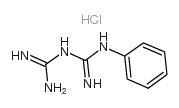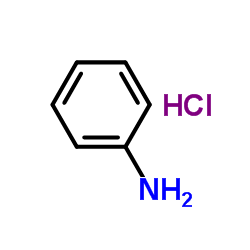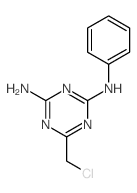1-phenylbiguanide hydrochloride

1-phenylbiguanide hydrochloride structure
|
Common Name | 1-phenylbiguanide hydrochloride | ||
|---|---|---|---|---|
| CAS Number | 55-57-2 | Molecular Weight | 213.66700 | |
| Density | 1.33g/cm3 | Boiling Point | 388.4ºC at 760mmHg | |
| Molecular Formula | C8H12ClN5 | Melting Point | 244-247ºC(lit.) | |
| MSDS | Chinese USA | Flash Point | 188.7ºC | |
| Symbol |

GHS07 |
Signal Word | Warning | |
| Name | 1-(diaminomethylidene)-2-phenylguanidine,hydrochloride |
|---|---|
| Synonym | More Synonyms |
| Density | 1.33g/cm3 |
|---|---|
| Boiling Point | 388.4ºC at 760mmHg |
| Melting Point | 244-247ºC(lit.) |
| Molecular Formula | C8H12ClN5 |
| Molecular Weight | 213.66700 |
| Flash Point | 188.7ºC |
| Exact Mass | 213.07800 |
| PSA | 97.78000 |
| LogP | 2.68200 |
| InChIKey | FHUDRDSKZQDCBC-UHFFFAOYSA-N |
| SMILES | Cl.NC(N)=NC(N)=Nc1ccccc1 |
| Storage condition | Store at RT |
|
Section1. IDENTIFICATION OF THE SUBSTANCE/MIXTURE Product identifiers Product name: 1-Phenylbiguanide hydrochloride CAS-No.: 55-57-2 Relevant identified uses of the substance or mixture and uses advised against Identified uses: Laboratory chemicals, Manufacture of substances Section2. HAZARDS IDENTIFICATION Classification of the substance or mixture Classification according to Regulation (EC) No 1272/2008 [EU-GHS/CLP] Acute toxicity, Oral (Category 4) Not a hazardous substance or mixture according to EC-directives 67/548/EEC or 1999/45/EC. Label elements Labelling according Regulation (EC) No 1272/2008 [CLP] Pictogram Signal wordWarning Hazard statement(s) H302Harmful if swallowed. Precautionary statement(s)none Supplemental Hazardnone Statements Other hazards - none Section3. COMPOSITION/INFORMATION ON INGREDIENTS Substances Formula: C8H11N5 · HCl Molecular Weight: 213,67 g/mol Section4. FIRST AID MEASURES Description of first aid measures General advice Consult a physician. Show this safety data sheet to the doctor in attendance. If inhaled If breathed in, move person into fresh air. If not breathing, give artificial respiration. Consult a physician. In case of skin contact Wash off with soap and plenty of water. Consult a physician. In case of eye contact Flush eyes with water as a precaution. If swallowed Never give anything by mouth to an unconscious person. Rinse mouth with water. Consult a physician. Most important symptoms and effects, both acute and delayed To the best of our knowledge, the chemical, physical, and toxicological properties have not been thoroughly investigated. Indication of any immediate medical attention and special treatment needed no data available Section5. FIREFIGHTING MEASURES Extinguishing media Suitable extinguishing media Use water spray, alcohol-resistant foam, dry chemical or carbon dioxide. Special hazards arising from the substance or mixture Carbon oxides, nitrogen oxides (NOx), Hydrogen chloride gas Advice for firefighters Wear self contained breathing apparatus for fire fighting if necessary. Further information no data available Section6. ACCIDENTAL RELEASE MEASURES Personal precautions, protective equipment and emergency procedures Use personal protective equipment. Avoid dust formation. Avoid breathing vapors, mist or gas. Ensure adequate ventilation. Avoid breathing dust. Environmental precautions Do not let product enter drains. Methods and materials for containment and cleaning up Pick up and arrange disposal without creating dust. Sweep up and shovel. Keep in suitable, closed containers for disposal. Reference to other sections For disposal see section 13. Section7. HANDLING AND STORAGE Precautions for safe handling Avoid contact with skin and eyes. Avoid formation of dust and aerosols. Provide appropriate exhaust ventilation at places where dust is formed.Normal measures for preventive fire protection. Conditions for safe storage, including any incompatibilities Store in cool place. Keep container tightly closed in a dry and well-ventilated place. Specific end uses no data available Section8. EXPOSURE CONTROLS/PERSONAL PROTECTION Control parameters Components with workplace control parameters Exposure controls Appropriate engineering controls Handle in accordance with good industrial hygiene and safety practice. Wash hands before breaks and at the end of workday. Personal protective equipment Eye/face protection Safety glasses with side-shields conforming to EN166 Use equipment for eye protection tested and approved under appropriate government standards such as NIOSH (US) or EN 166(EU). Skin protection Handle with gloves. Gloves must be inspected prior to use. Use proper glove removal technique (without touching glove's outer surface) to avoid skin contact with this product. Dispose of contaminated gloves after use in accordance with applicable laws and good laboratory practices. Wash and dry hands. The selected protective gloves have to satisfy the specifications of EU Directive 89/686/EEC and the standard EN 374 derived from it. Body Protection Complete suit protecting against chemicals, The type of protective equipment must be selected according to the concentration and amount of the dangerous substance at the specific workplace. Respiratory protection For nuisance exposures use type P95 (US) or type P1 (EU EN 143) particle respirator.For higher level protection use type OV/AG/P99 (US) or type ABEK-P2 (EU EN 143) respirator cartridges. Use respirators and components tested and approved under appropriate government standards such as NIOSH (US) or CEN (EU). Section9. PHYSICAL AND CHEMICAL PROPERTIES Information on basic physical and chemical properties a) AppearanceForm: powder Colour: white b) Odourno data available c) Odour Thresholdno data available d) pHno data available e) Melting point/freezingMelting point/range: 244 - 247 °C - lit. point f) Initial boiling point and no data available boiling range g) Flash pointno data available h) Evaporation rateno data available i) Flammability (solid, gas) no data available j) Upper/lowerno data available flammability or explosive limits k) Vapour pressureno data available l) Vapour densityno data available m) Relative densityno data available n) Water solubilityno data available o) Partition coefficient: n- no data available octanol/water p) Autoignitionno data available temperature q) Decompositionno data available temperature r) Viscosityno data available s) Explosive propertiesno data available t) Oxidizing propertiesno data available Other safety information no data available Section10. STABILITY AND REACTIVITY Reactivity no data available Chemical stability no data available Possibility of hazardous reactions no data available Conditions to avoid no data available Incompatible materials Strong oxidizing agents Hazardous decomposition products Other decomposition products - no data available Section11. TOXICOLOGICAL INFORMATION Information on toxicological effects Acute toxicity LD50 Oral - mouse - 1.200 mg/kg Skin corrosion/irritation no data available Serious eye damage/eye irritation no data available Respiratory or skin sensitization no data available Germ cell mutagenicity no data available Carcinogenicity IARC:No component of this product present at levels greater than or equal to 0.1% is identified as probable, possible or confirmed human carcinogen by IARC. Reproductive toxicity no data available Specific target organ toxicity - single exposure no data available Specific target organ toxicity - repeated exposure no data available Aspiration hazard no data available Potential health effects InhalationMay be harmful if inhaled. May cause respiratory tract irritation. IngestionHarmful if swallowed. SkinMay be harmful if absorbed through skin. May cause skin irritation. Eyes May cause eye irritation. Signs and Symptoms of Exposure To the best of our knowledge, the chemical, physical, and toxicological properties have not been thoroughly investigated. Additional Information RTECS: DU2550000 Section12. ECOLOGICAL INFORMATION Toxicity no data available Persistence and degradability no data available Bioaccumulative potential no data available Mobility in soil no data available Results of PBT and vPvB assessment no data available Other adverse effects no data available Section13. DISPOSAL CONSIDERATIONS Waste treatment methods Product Offer surplus and non-recyclable solutions to a licensed disposal company. Contact a licensed professional waste disposal service to dispose of this material. Dissolve or mix the material with a combustible solvent and burn in a chemical incinerator equipped with an afterburner and scrubber. Contaminated packaging Dispose of as unused product. Section14. TRANSPORT INFORMATION UN number ADR/RID: -IMDG: -IATA: - UN proper shipping name ADR/RID: Not dangerous goods IMDG: Not dangerous goods IATA:Not dangerous goods Transport hazard class(es) ADR/RID: -IMDG: -IATA: - Packaging group ADR/RID: -IMDG: -IATA: - Environmental hazards ADR/RID: noIMDG Marine pollutant: noIATA: no Special precautions for user no data available Section15. REGULATORY INFORMATION This safety datasheet complies with the requirements of Regulation (EC) No. 1907/2006. Safety, health and environmental regulations/legislation specific for the substance or mixture no data available Chemical Safety Assessment no data available Section16. OTHER INFORMATION Further information Copyright 2012 Co. LLC. License granted to make unlimited paper copies for internal use only. The above information is believed to be correct but does not purport to be all inclusive and shall be used only as a guide. The information in this document is based on the present state of our knowledge and is applicable to the product with regard to appropriate safety precautions. It does not represent any guarantee of the properties of the product. Corporation and its Affiliates shall not be held liable for any damage resulting from handling or from contact with the above product. See and/or the reverse side of invoice or packing slip for additional terms and conditions of sale. |
CHEMICAL IDENTIFICATION
HEALTH HAZARD DATAACUTE TOXICITY DATA
|
|
~% 
1-phenylbiguani... CAS#:55-57-2 |
| Literature: Smolka; Friedreich Monatshefte fuer Chemie, 1888 , vol. 9, p. 230 |
|
~% 
1-phenylbiguani... CAS#:55-57-2 |
| Literature: Maarouf, Azza R.; Farahat, Abdelbasset A.; Selim, Khalid B.; Eisa, Hassan M. Medicinal Chemistry Research, 2012 , vol. 21, # 6 p. 703 - 710 |
|
Indian red scorpion venom-induced augmentation of cardio-respiratory reflexes and pulmonary edema involve the release of histamine.
Toxicon 57(2) , 193-8, (2011) Pulmonary edema is a consistent feature of Mesobuthus tamulus (MBT) envenomation. Kinins, prostaglandins and other inflammatory mediators are implicated in it. Since, histamine also increases capillar... |
|
|
Effect of 3,5-dicarbomethoxyphenylbiguanide on free radical homeostasis in rats with experimental myocarditis.
Bull. Exp. Biol. Med. 154(2) , 192-5, (2012) Administration of 3,5-dicarbomethoxyphenylbiguanide to rats with experimental epinephrine-induced myocarditis was followed by a decrease in activity of marker enzymes for cardiomyocyte cytolysis in th... |
|
|
B(2) kinin receptors mediate the Indian red scorpion venom-induced augmentation of visceral reflexes via the nitric oxide cyclic guanosine monophosphate pathway.
Acta Physiol. (Oxf.) 196(4) , 365-73, (2009) This study was performed to delineate the kinin (receptor)-dependent pathways in the Indian red scorpion (Mesobuthus tamulus; MBT) venom-induced pulmonary oedema as well as the augmentation of cardio-... |
| Phenylbiguanide monohydrochloride |
| Phenylbiguanide hydrochloride |
| 1-phenylbiguanide hydrochloride |
| MFCD00035040 |
| N-phenylbiguanide hydrochloride |
| Phenyldiguanide hydrochloride |
| EINECS 200-239-2 |
| N'-Phenylbiguanide monohydrochloride |
| N-phenylimidodicarbonimidic diamide hydrochloride |
| 1-Phenylbiquanide hydrochloride |
| 1-Phenylbiguanide monohydrochloride |
| 1-phenyl-biguanidium chloride |
| 1-phenyl-biguanide hydrogenchloride |


 CAS#:30355-60-3
CAS#:30355-60-3 CAS#:7426-35-9
CAS#:7426-35-9 CAS#:537-17-7
CAS#:537-17-7
